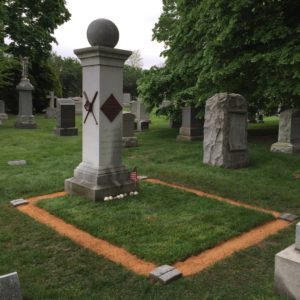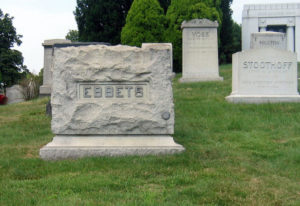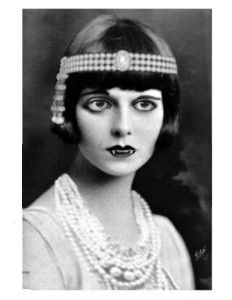CHAPTER EIGHT
Bimbo and the Beast

Henry Chadwick was a sportswriter and is known as the “Father of Baseball” for his early reporting on and contributions to the development of the game. Chadwick died in 1908 and is interred at Green-Wood Cemetery in Brooklyn, New York, where he lived for most of his life. “Father of Base Ball” is inscribed on his grave marker. His grave site is neatly outlined with stone “bases” and bronze reliefs of baseball bats, a fielder’s glove, and a catcher’s mask decorate the sides of his gravestone.
Photo source
Seven miles to the north, another young woman was opening her eyes for the first time since daybreak. She leaned over and kissed the cheek of the rigid figure whose cozy quarters she had shared.
“G’nite, Chawlie!” she said in a high-pitched voice edged with a thick Brooklyn accent.
The girl folded her hands over her chest and her body convulsed violently. Her right arm jerked upward and her left leg kicked forward. Chawlie didn’t stir.
She repeated the same crazed movement with her left arm and right leg. The wooden canopy in front of her nose began to wobble and open ever so slowly. A dusting of soil trickled into the chamber, but the girl slipped out and slammed the lid before any significant accumulation.
It was this technique—this hermetic performance of the Charleston—that had earned her the name “Flapper.” Although there were hundreds of girls within two city blocks who considered themselves “flappers,” among her kind she was the Flapper.
At least in her own head.
The shadow of the Kamies Monument fell upon her, but Flapper neither noticed nor cared that she was standing upon the highest point in Brooklyn. She gazed at the distant New York Harbor and then examined the ground at her feet.
“Hot diggity! Mother Nature gave the snow a bum’s rush,” she smiled.
In addition to the way she could sneak into buried caskets, Flapper had also learned how to mentally manipulate a piece of turf so that it folded back like a throw rug. Once she had wiggled into her daytime abode, the turf rolled back into place.
It was an essential skill for dewdroppers who preferred to spend their daylight hours under manicured lawns of five-star accommodations, like the one here at Green-Wood Cemetery. But it was always so much more difficult when a layer of snow blanketed the ground.
With a nod of her head, Flapper beckoned the sod to unfurl. She smoothed its surface as though it were a delicate duvet. When she was satisfied that the grave looked as placid as when she had found it, Flapper stood and patted the headstone of its now lonesome occupant.

Another baseball legend buried at Green-Wood is Charles Ebbets, the owner of the Brooklyn Dodgers from 1902 till his death in 1925. The Dodgers played in the stadium built by Ebbets on an area in Flatbush known as “Pigtown,” a local dump where nine separate trolley car lines converged. In fact, the team’s name derived from the reputed skill of Brooklyn residents at evading the city’s trolley streetcar network. The team continued to play at Ebbets Field until 1957, when it moved to Los Angeles. Ebbets’ tombstone is much less grandiose than Chadwick’s.
Photo source
It was a simple stone. No dates, no first name, no epitaph. Just the name “Ebbets” carved in capital letters on a rectangular stone slab. Flapper knew very little about the man she had slept with except that he once owned a baseball team that still played three miles to the east in a stadium bearing his name.
When Flapper first came to New York, she had dreamed of becoming a movie star. But her friends told her that the only way she’d become famous would be to sleep with famous people.
The previous day Flapper had cuddled up for the day with Henry Chadwick, another baseball legend she had never heard of. But she could tell that “Hank” had been quite a pip in his day.
Unlike Charlie, Hank had ritzy digs! There were stones shaped like bases in the ground surrounding the grave and a granite baseball that adorned the top of his monument-like headstone.
But Henry had died eighteen years ago, so he wasn’t a very cozy snuggle pup. She preferred the recently deceased and their jerky-like texture. Not too recent—she hated the smell of embalming fluid. Charlie had passed away less than a year ago, and that was just dandy.
Flapper glided across the cemetery lawn wearing nothing but a petticoat and a low-cut black bodice that flattened her bust beneath a spider-web pattern of lace. She wished that her clothing was as durable as her skin, which repelled soot and soil like polished marble. To protect tonight’s ensemble from the elements, Flapper had hidden it beneath the massive brownstone overlay of the Pierrepont family tomb.
It was a sleeveless purple number with sequins that clicked as she snatched it from its hiding place. When Flapper finished putting on the cloche hat, peacock feather, gold lamé, and flapping galoshes, she looked like a walking Vanity Fair ad.
 Her nails were long and cut to a point, a style that would endure on her forever. So would her raven hair, which was cut into a perpetual boyish bob.
Her nails were long and cut to a point, a style that would endure on her forever. So would her raven hair, which was cut into a perpetual boyish bob.
The makeup on her face always looked immaculate, but that was because she wore no makeup at all. No kohl, no fake lashes—her eyes were naturally dark and alluring. She wore no lipstick to accentuate her mouth because her lips would permanently retain their crimson-colored Cupid’s bow shape. And she needed no lily-white foundation because she already had the flawless complexion of a porcelain doll.
Flapper slipped through the towering churchlike arch that graced the main entrance to Green-Wood and the landscape quickly degenerated into a maze of hybrid squalor. She walked up several blocks until the sound of oily waves against the fetid docks of the Gowanus beckoned her down a row of shabby brick houses along 20th Street.
Hordes of scoundrels and lowlifes shouted and sang along the thoroughfare while furtive hands extinguished lights or drew blinds behind barred windows as she passed. A swarthy, sin-pitted face sprung up in front of her, blocking her passage.
In her former life, Flapper would have backed off and screamed. But now she held her ground and even managed a slight smile, though the man’s breath was fouler than the stench of the neighboring bay.
“You shouldn’t be walkin’ these streets alone, doll,” the miscreant warned.
Flapper knew the man had no concern for her welfare. His warning was a mere ruse to bait pretty young women so he could bask in the glimmer of their unforeseen dread.
“Never again,” Flapper whispered.
The pock-faced man cocked his head. This was not the response he had expected. He pulled his black knit hat halfway over his ears, emphasizing the odd shape of his head. It had the same angular contours as the head of the man who had spawned Flapper’s “rebirth” seven years before.






